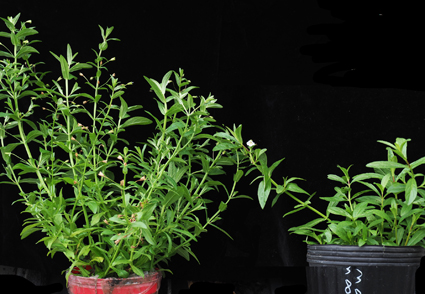Abstract
Mimulicalyx is an oligotypic genus including two species that are endemic to southwest China. Based on investigation of the rediscovered populations of M. rosulatus and M. paludigenus, examination of their herbarium specimens (including types), as well as consultation of their protologues and distributions, no obvious morphological differences could be found and we thus concluded that they are conspecific. Therefore, M. paludigenus is reduced as a synonym of M. rosulatus. Field photographs and an updated morphological description of M. rosulatus are provided.
References
Albach, D.C., Yan, K., Jensen, S.R. & Li, H.Q. (2009) Phylogenetic placement of Triaenophora (formerly Scrophulariaceae) with some implications for the phylogeny of Lamiales. Taxon 58: 749–756. https://doi.org/10.1002/tax.583005
Fischer, F.E.L. & Meyer, C.A. (1835) Index seminum, quae Hortus Botanicus Imperialis Petropolitanus pro mutua commutatione offert: accedunt Animadversiones botanicae nonnullae. Hortus, St. Petersburg, 42 pp.
Hong, D.Y., Yang, H.B., Jin, C.L., Fischer, M.A., Holmgren, N.H. & Mill, R.R. (1998) Mimulicalyx. In: Wu, Z.Y. & Peter, H.R. (eds.) Flora of China. Vol. 18. Science Press, Beijing & Missouri Botanical Garden Press, St. Louis, pp. 52–53.
Hooker, J.D. (1891) Rehmannia (Trianophora) rupestris, native of China. Botanical Magazine tab. 7191.
Jin, S.Y. & Chen, Y.L. (1994) A catalogue of type specimens (Cormophyta) in the herbaria of China. Science Press, Beijing, 716 pp.
Li, D.Z. & Cai, J. (2005) Validation of Mimulicalyx paludigenus (Scrophulariaceae), a species endemic to China. Novon 15: 319.
Li, X., Feng, T., Randel, C. & Schneeweiss, G.M. (2019) Phylogenetic relationships in Orobanchaceae inferred from low-copy nuclear genes: consolidation of major clades and identification of a novel position of the non-photosynthetic Orobanche clade sister to all other parasitic Orobanchaceae. Frontiers in Plant Science 10: 902. https://doi.org/10.3389/fpls.2019.00902
Lin, Q., Sun, M., Sun, Q., Bei, S.Q., Li, H.L. & Yang, Z.R. (2009) Validation of eight names of Chinese taxa in Ranunculaceae, Rosaceae and Scrophulariaceae. Kew Bulletin 64: 573–575. https://doi.org/10.1007/s12225-009-9147-x
Liu, B, Tan, Y.H., Liu, S., Olmstead, R.G., Min, D.Z., Chen, Z.D., Joshee, N., Vaidya, B.N., Chung, R.C.K. & Li, B. (2020) Phylogenetic relationships of Cyrtandromoea and Wightia revisited: a new tribe in Phrymaceae and a new family in Lamiales. Journal of Systematics and Evolution 58: 1–17. https://doi.org/10.1111/jse.12513
Solereder, S. (1909) Uber die gattung Rehmannia. Berichte der Deutschen Botanischen Gesellschaft 27: 390–404.
Thiers, B. (2021+) Index Herbariorum: A global directory of public herbaria and associated staff. New York Botanical Garden’s Virtual Herbarium. http://sweetgum.nybg.org/ih/ [accessed 10 March 2021]
Tsoog, P.C. (1979) Mimulicalyx. In: Tsoog, P.C. & Yang, H.P. (eds.) Flora Reipublicae Popularis Sinicae. Vol. 67 (2). Science Press, Beijing, pp. 209–211, 400.
Turland, N.J., Wiersema, J.H., Barrie, F.R., Greuter, W., Hawksworth, D.L., Herendeen, P.S., Knapp, S., Kusber, W.H., Li, D.Z., Marhold, K., May, T.W., McNeill, J., Monro, A.M., Prado, J., Price, M.J. & Smith, G.F. (2018) International Code of Nomenclature for algae, fungi, and plants (Shenzhen Code) adopted by the Nineteenth International Botanical Congress Shenzhen, China, July 2017. Regnum Vegetabile 159. Glashütten: Koeltz Botanical Books. https://doi.org/10.12705/Code.2018
Wu, Z.Y. (2006) Mimulicalyx. In: Institutum Botanicum Kunmingense Academiae Sinicae (eds.) Flora Yunnanica. Vol. 16. Beijing: Science Press, pp. 419–421.
Wu, Z.Y. & Peter, H.R. (1998) Mimulicalyx. In: Wu, Z.Y. & Peter, H.R. (eds.) Flora of China Illustrations. Vol. 18. Science Press, Beijing & Missouri Botanical Garden Press, St. Louis, pp. 81.
Xia, Z., Wang, Y.Z. & Smith, J.F. (2009) Familial placement and relations of Rehmannia and Triaenophora (Scrophulariaceae s.l.) inferred from five gene regions. American Journal of Botany 96: 519–530. https://doi.org/10.3732/ajb.0800195
Xiang, X.L., Pan, H.L., Min, D.Z., Zhang, D.G., Zhao, F., Liu, B. & Li, B. (2020) Rediscovery of Mazus lanceifolius reveals a new genus and a new species in Mazaceae. PhytoKeys 171: 1–24. https://doi.org/10.3897/phytokeys.171.61926


